To brew your own herbal headache relief tea, start with a blend of feverfew, peppermint, and ginger as your core ingredients. Add chamomile and lemon balm for extra soothing effects. Use about 1-2 teaspoons of dried herbs per cup of hot water, and steep for 5-15 minutes depending on the herb. Sweeten with honey if desired, but avoid overdoing it. Sip your tea slowly in a calm environment to maximize its benefits. Remember that while herbal teas can be effective, they may have side effects or interact with medications. By understanding each herb's properties, you'll be able to create a personalized blend tailored to your needs.
Understanding Headache-Relieving Herbs

Steering through the world of herbal remedies can be overwhelming, but understanding headache-relieving herbs is vital for creating an effective tea blend.
You'll want to focus on herbs known for their pain-relieving and anti-inflammatory properties. Feverfew, for instance, contains parthenolide, which can help reduce migraine frequency and severity.
Peppermint's menthol content acts as a natural analgesic and muscle relaxant, easing tension headaches. Ginger is another powerful ally, thanks to its anti-inflammatory compounds that can alleviate headache pain.
Chamomile's calming effects may help with stress-induced headaches, while lavender can promote relaxation and reduce tension. Lemon balm and passionflower are also known for their soothing properties, potentially easing headache symptoms.
When selecting herbs, opt for organic varieties to avoid pesticide residues.
Remember that some herbs may interact with medications or have side effects, so it's important to consult with a healthcare professional before incorporating them into your routine.
Essential Ingredients for Your Blend
Armed with knowledge about headache-relieving herbs, you're ready to select the key ingredients for your blend. Start with feverfew, a potent herb known for its migraine-fighting properties.
Add peppermint leaves to soothe tension and promote relaxation. Incorporate chamomile flowers for their calming effects and ability to reduce inflammation.
Don't forget about ginger root, which can help alleviate nausea often associated with headaches. Lemon balm leaves offer a mild sedative effect and can ease stress-induced headaches.
Consider including rosemary, which improves circulation and may reduce headache intensity. For a touch of sweetness and additional benefits, add a small amount of stevia leaves. They're natural sweeteners that won't spike your blood sugar.
Lavender buds can provide a pleasant aroma and further enhance relaxation.
When crafting your blend, aim for a balanced mix of flavors and therapeutic properties. Start with equal parts of the primary ingredients (feverfew, peppermint, and chamomile), then add smaller amounts of the other herbs to taste.
Experiment with different ratios to find your perfect combination. Remember, the key is to create a tea that's both effective and enjoyable to drink.
Choosing the Right Tea Base

While your herbal blend forms the core of your headache relief tea, choosing the right tea base can enhance its effectiveness and flavor. Consider using green tea as your base, as it contains caffeine and L-theanine, which can help reduce pain and promote relaxation.
Alternatively, white tea offers a milder flavor and lower caffeine content, making it suitable for those sensitive to stimulants. For a caffeine-free option, rooibos tea provides a rich, nutty flavor and contains antioxidants that may help reduce inflammation.
When selecting your tea base, keep these factors in mind:
- Caffeine content: Higher levels can alleviate pain but may cause jitters
- Flavor profile: Confirm it complements your herbal blend without overpowering it
- Antioxidant properties: Look for teas rich in polyphenols to combat oxidative stress
Remember to choose organic, high-quality teas to avoid pesticides and other contaminants.
Steep your tea base according to its specific requirements before adding your herbal blend. This approach guarantees you extract the full benefits from both the tea base and your carefully selected herbs, creating a potent and flavorful headache relief tea.
Balancing Flavors and Benefits
Creating a balanced herbal headache relief tea requires careful consideration of both flavor and therapeutic benefits. You'll want to combine herbs that target pain relief with those that enhance taste and aroma. Start with your chosen tea base and add herbs known for their headache-fighting properties, such as feverfew, butterbur, or willow bark. Then, incorporate flavor-enhancing herbs like peppermint, lemon balm, or chamomile.
Here's a guide to help you balance flavors and benefits:
| Herb | Flavor Profile | Headache Relief | Recommended Amount |
|---|---|---|---|
| Feverfew | Bitter | Strong | 1 tsp dried leaves |
| Peppermint | Cooling, minty | Moderate | 1-2 tsp dried leaves |
| Lemon Balm | Citrusy, mild | Mild | 1-2 tsp dried leaves |
| Chamomile | Floral, sweet | Mild | 1-2 tsp dried flowers |
| Ginger | Spicy, warm | Moderate | 1/2 tsp dried root |
Experiment with different combinations to find your perfect blend. Remember, some herbs may interact with medications or have side effects, so consult a healthcare professional before using them regularly. Start with small amounts and adjust as needed to achieve the desired flavor and effectiveness.
Proper Herb Ratios
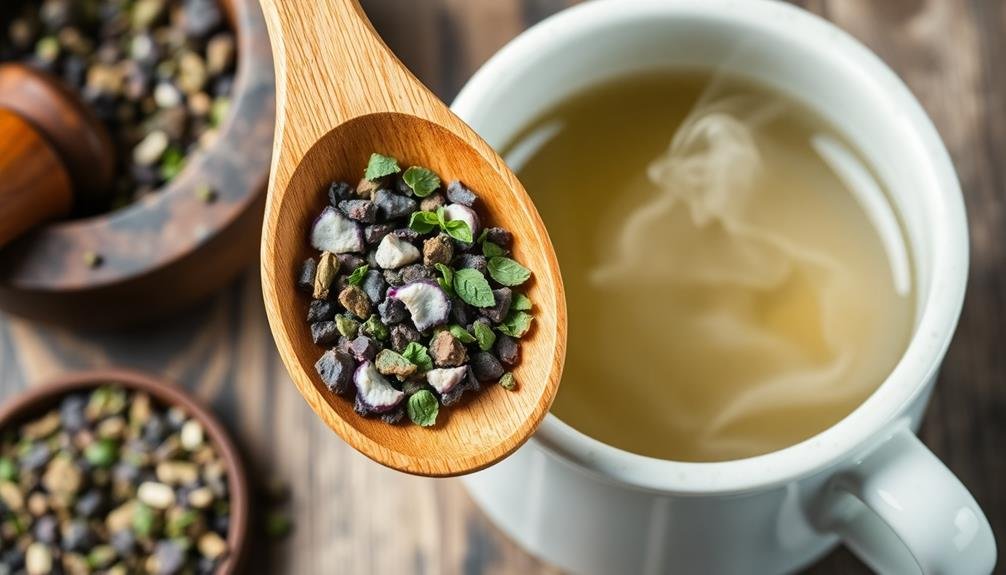
Now that you've learned about balancing flavors and benefits, let's focus on getting the proper herb ratios in your headache relief tea. The key to an effective herbal blend lies in using the right proportions of each ingredient. Generally, you'll want to use a larger amount of your primary herb, which targets the main symptom, and smaller amounts of supporting herbs.
For a basic headache relief tea, consider this ratio:
- 2 parts feverfew (main pain-relieving herb)
- 1 part peppermint (for added relief and flavor)
- 1/2 part ginger (to boost circulation and reduce inflammation)
Start with 1 teaspoon as your base unit and adjust accordingly. For example, use 2 teaspoons of feverfew, 1 teaspoon of peppermint, and 1/2 teaspoon of ginger.
Remember, these ratios aren't set in stone. You can tweak them based on your personal preferences and how your body responds.
If you're adding other herbs like chamomile or lemon balm for relaxation, keep them to 1/2 part or less to maintain the tea's headache-fighting potency. Always start with smaller amounts and gradually increase as needed, paying attention to how your body reacts to the blend.
Drying and Storing Ingredients
The freshness of your herbs is essential for a potent headache relief tea. To maintain their potency, you'll need to dry and store your ingredients properly.
Start by harvesting herbs on a dry, sunny morning after the dew has evaporated. Gently rinse them and pat them dry with a clean towel.
For air-drying, tie small bundles of herbs with twine and hang them upside down in a warm, dry, and well-ventilated area away from direct sunlight. Alternatively, use a food dehydrator set to a low temperature (95-115°F) for faster results.
Once your herbs are completely dry and crisp to the touch, store them in airtight glass jars or containers. Label each container with the herb's name and drying date.
Keep them in a cool, dark place to preserve their flavor and medicinal properties. Whole dried herbs can last up to a year when stored correctly, while powdered herbs typically maintain their potency for about six months.
Always check your stored herbs for signs of mold or discoloration before use. By following these drying and storing techniques, you'll guarantee your headache relief tea remains effective and flavorful.
Equipment Needed for Brewing
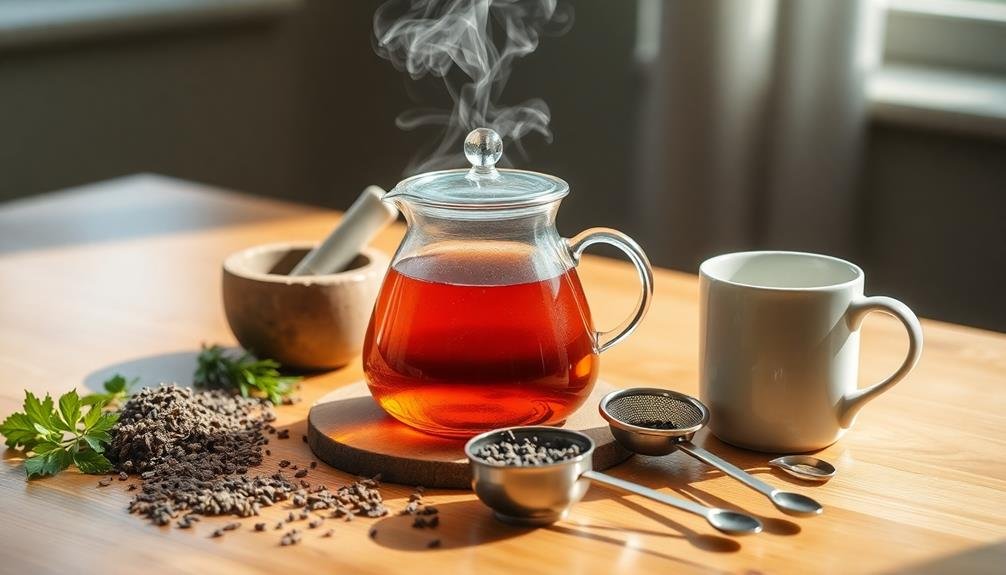
With your dried herbs ready, it's time to gather the right equipment for brewing your headache relief tea. You'll need a few essential items to guarantee a proper infusion and a pleasant drinking experience.
First, invest in a quality tea infuser or strainer. A stainless steel mesh ball or a reusable cloth tea bag works well for loose herbs. If you prefer, you can use a teapot with a built-in infuser basket.
Next, select a heat-resistant glass or ceramic mug to brew and drink your tea. Avoid plastic containers, as they may affect the taste and potentially leach chemicals into your hot beverage.
For precise brewing, you'll need a thermometer to monitor water temperature and a timer to track steeping time. Different herbs require specific temperatures and steeping durations for ideal flavor and medicinal benefits.
Finally, don't forget a kettle or pot for boiling water.
Here's a quick checklist of equipment you'll need:
- Tea infuser or strainer
- Heat-resistant mug or teapot
- Thermometer and timer
With these tools on hand, you're ready to brew your personalized herbal headache relief tea and enjoy its soothing benefits.
Steeping Time and Temperature
Proper steeping time and temperature are essential for extracting the maximum therapeutic benefits from your herbal headache relief tea. For most herbal teas, you'll want to use water that's just off the boil, around 200°F (93°C). If you don't have a thermometer, bring water to a boil and let it sit for about 30 seconds before pouring over your herbs.
Steeping time varies depending on the herbs you're using. For delicate herbs like peppermint or chamomile, steep for 5-7 minutes. Stronger herbs like ginger or feverfew may require 10-15 minutes. If you're using a blend, aim for the longer steeping time to guarantee all herbs release their properties.
Don't over-steep your tea, as this can lead to a bitter taste and potentially reduce the effectiveness of some compounds. Set a timer to avoid forgetting your brew. Once the steeping time is up, remove the herbs or tea bag immediately.
For a stronger brew, increase the amount of herbs rather than the steeping time. This guarantees you're getting more of the beneficial compounds without risking over-extraction of bitter elements.
Enhancing Your Tea's Potency

While your herbal headache relief tea can be effective on its own, you can enhance its potency through several simple methods. Consider adding a teaspoon of raw honey to your brew, as it's known for its anti-inflammatory properties and can help soothe headaches.
You might also try incorporating a slice of fresh ginger or a few drops of peppermint essential oil, both of which can boost the tea's pain-relieving effects.
To further amplify your tea's potency, try these techniques:
- Combine complementary herbs: Mix chamomile with lavender or pair feverfew with lemon balm to create a more powerful blend.
- Use fresh herbs when possible: Fresh herbs often contain higher concentrations of active compounds than their dried counterparts.
- Cover your cup while steeping: This traps the steam and essential oils, resulting in a more potent infusion.
Don't hesitate to experiment with different combinations and methods to find what works best for you.
Sweetening Options for Taste
When considering sweetening your herbal headache relief tea, you'll face the choice between natural and artificial sweeteners.
You might opt for natural options like honey or stevia, which can complement the tea's therapeutic properties without adding unnecessary chemicals.
Additionally, you can enhance both the flavor and efficacy of your tea by combining complementary herbs, such as peppermint or chamomile, which can provide additional soothing effects.
Natural vs. Artificial Sweeteners
Many people prefer to sweeten their herbal headache relief tea for a more enjoyable experience. When choosing a sweetener, you'll need to decide between natural and artificial options.
Natural sweeteners, like honey, maple syrup, or stevia, offer additional health benefits and a more complex flavor profile. They're often less processed and contain trace minerals and antioxidants. On the other hand, artificial sweeteners provide sweetness without calories, making them popular among those watching their sugar intake.
Consider these factors when selecting a sweetener for your headache relief tea:
- Taste preference: Natural sweeteners tend to have distinct flavors, while artificial ones aim for a neutral sweetness.
- Health impact: Natural options may affect blood sugar levels, while artificial sweeteners don't.
- Quantity needed: You'll typically use less artificial sweetener than natural options to achieve the same level of sweetness.
Ultimately, the choice between natural and artificial sweeteners depends on your personal preferences and health goals.
Experiment with different options to find the one that complements your herbal tea without overpowering its beneficial properties. Remember, moderation is key regardless of which sweetener you choose.
Flavor-Enhancing Herb Combinations
Several herb combinations can enhance the flavor of your headache relief tea while providing additional health benefits. Consider adding lemon balm and chamomile for a soothing, floral taste that promotes relaxation.
Peppermint and ginger create an invigorating blend that aids digestion and reduces nausea, common side effects of headaches. For a spicier option, mix cinnamon and clove, which offer anti-inflammatory properties and a warming sensation.
You can also experiment with lavender and rosemary for a fragrant combination that may improve circulation and reduce stress. If you prefer a sweeter taste, try adding stevia leaves or a touch of raw honey. These natural sweeteners won't spike your blood sugar levels like refined sugar does.
Don't forget about the power of citrus fruits. Adding a slice of lemon, lime, or orange to your tea can brighten the flavor and provide a boost of vitamin C.
For a more complex taste profile, combine three or four herbs from different flavor categories. This approach allows you to create a personalized blend that suits your palate while maximizing the tea's therapeutic effects.
Serving and Enjoying Your Tea

The art of savoring your herbal headache relief tea enhances its therapeutic benefits. Take a moment to find a quiet, comfortable spot where you can fully relax and focus on the experience. As you prepare to sip your tea, inhale deeply to absorb the soothing aromas of the herbs you've carefully selected.
To fully enjoy your herbal headache relief tea:
- Sip slowly and mindfully, allowing the warm liquid to coat your mouth and throat.
- Take note of the flavors and sensations, appreciating the subtle notes of each herb.
- Practice deep, rhythmic breathing between sips to promote relaxation and oxygenation.
Don't rush through your tea-drinking experience. Instead, treat it as a form of self-care and meditation. If possible, dim the lights and minimize distractions to create a calming environment.
As you drink, visualize the herbs' healing properties working their magic on your body and mind. Remember, the act of slowing down and focusing on your tea can itself be a powerful stress-reducer, complementing the herbs' natural headache-relieving properties.
Potential Side Effects to Consider
While herbal teas are generally safe, it's important to be aware of potential side effects. Some herbs can interact with medications or cause allergic reactions in sensitive individuals. For example, chamomile may increase the risk of bleeding if you're taking blood thinners. Peppermint can worsen acid reflux in some people, while ginger might cause heartburn or stomach discomfort if consumed in large quantities.
Be cautious if you're pregnant or breastfeeding, as certain herbs can affect hormone levels or cross into breast milk. Feverfew, commonly used for migraines, should be avoided during pregnancy.
If you have pre-existing medical conditions, consult your healthcare provider before incorporating new herbal teas into your routine.
Pay attention to how your body responds to the tea. If you experience any unusual symptoms like nausea, dizziness, or skin rashes, discontinue use immediately.
Remember that "natural" doesn't always mean safe for everyone. Start with small amounts of new herbal teas and gradually increase consumption if you don't experience any adverse effects.
Customizing Your Blend

Now that you're aware of potential side effects, let's explore how to create a personalized herbal tea blend for headache relief.
Start by selecting a base herb like peppermint or chamomile, known for their soothing properties. Then, add complementary herbs that target specific symptoms. For tension headaches, consider including lavender or lemon balm. If you're dealing with sinus-related headaches, add ginger or eucalyptus.
Experiment with different ratios to find your perfect blend. A general rule of thumb is to use one teaspoon of dried herbs per cup of water. Don't be afraid to adjust the proportions based on your taste preferences and the intensity of relief you're seeking.
To get started, try this simple recipe:
- 2 parts peppermint leaves
- 1 part chamomile flowers
- 1 part feverfew leaves
Steep this mixture in hot water for 5-10 minutes, strain, and enjoy.
Frequently Asked Questions
How Long Can I Store My Homemade Herbal Headache Relief Tea Blend?
You can store your homemade herbal tea blend for up to 6 months in an airtight container, away from light and moisture. It's best to keep it in a cool, dark place to maintain its potency and freshness.
Can I Use Fresh Herbs Instead of Dried Ones in My Tea?
Yes, you can use fresh herbs in your tea. They'll provide a vibrant flavor, but you'll need to use more than dried herbs. Remember, fresh herbs don't store as long, so you'll want to use them quickly.
Is It Safe to Drink This Tea During Pregnancy or While Breastfeeding?
You should consult your healthcare provider before consuming any herbal teas during pregnancy or while breastfeeding. Some herbs can affect your baby or pregnancy. It's best to err on the side of caution with herbal remedies.
How Often Can I Consume Herbal Headache Relief Tea Without Adverse Effects?
You can safely drink herbal headache relief tea 2-3 times daily. However, it's best to consult your doctor, especially if you're taking medications. Don't exceed recommended doses, as overuse may lead to unwanted side effects.
Can I Add Caffeine to My Herbal Headache Relief Tea Blend?
You can add caffeine to your herbal headache relief tea blend, but it's not always recommended. Caffeine might help some headaches, but it can worsen others. Consider your personal tolerance and the specific herbs you're using before adding it.
In Summary
You've now learned how to create your own herbal headache relief tea. Remember to experiment with different combinations to find what works best for you. Don't forget to consult with a healthcare professional before adding new herbs to your routine, especially if you're taking medications. With practice, you'll perfect your blend and have a natural remedy at your fingertips. Enjoy the process of brewing and sipping your personalized, soothing tea whenever a headache strikes.


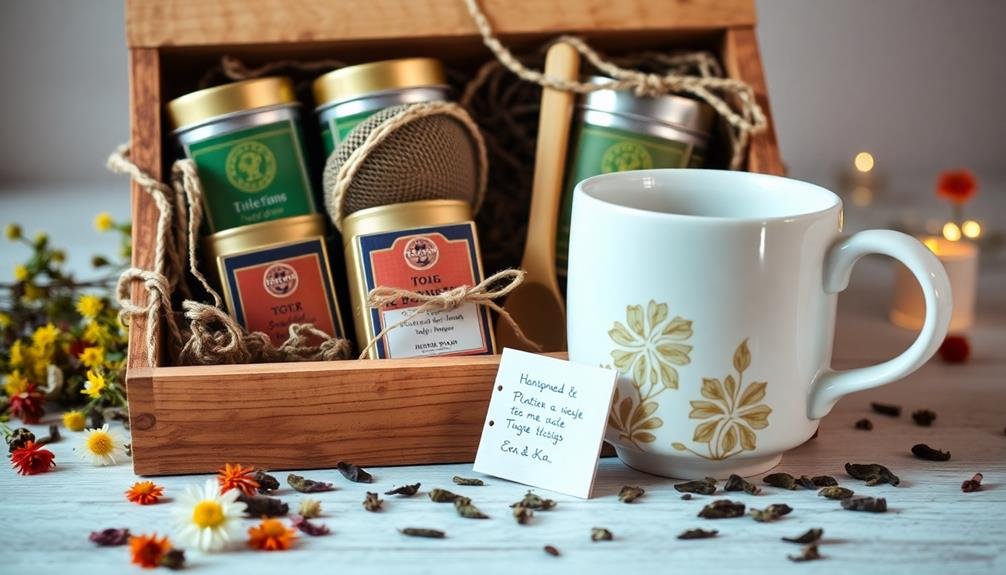
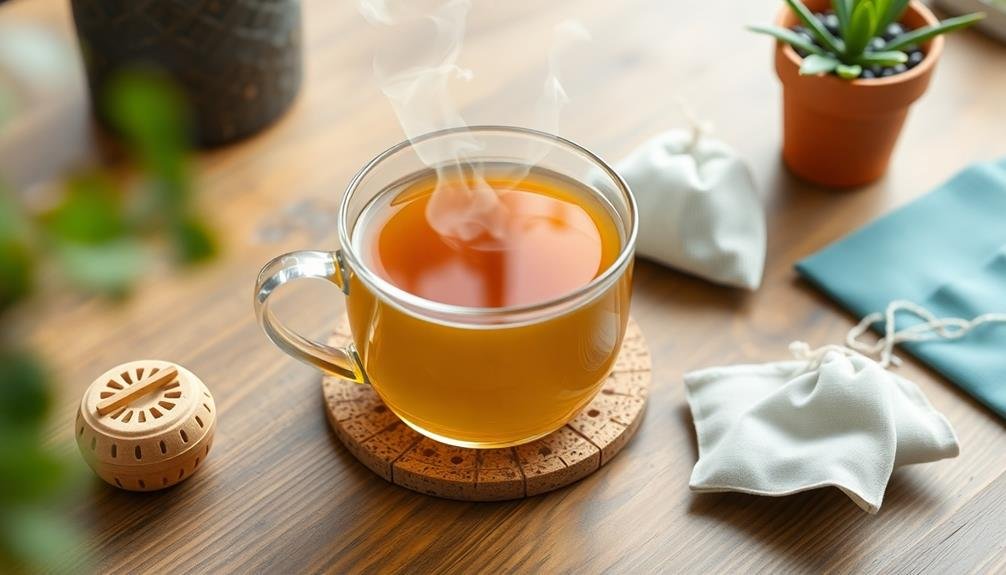
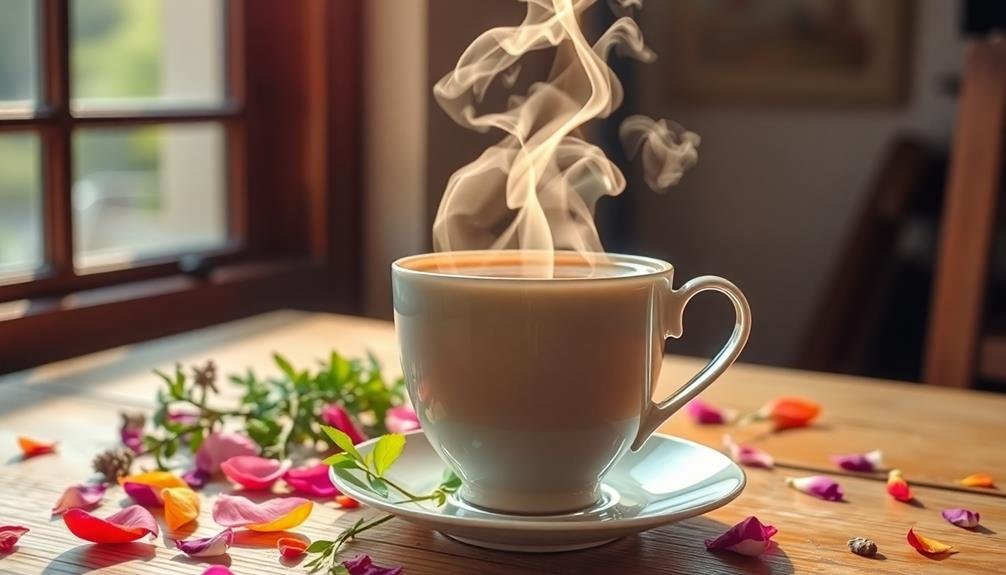
Leave a Reply